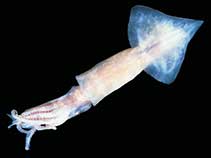Psychroteuthis glacialis Thiele, 1920
Glacial squid| Native range | All suitable habitat | Point map | Year 2050 |

|
| This map was computer-generated and has not yet been reviewed. |
| Psychroteuthis glacialis AquaMaps Data sources: GBIF OBIS |
Classification / Names Common names | Synonyms | CoL | ITIS | WoRMS
Cephalopoda | Teuthida | Psychroteuthidae
Environment: milieu / climate zone / depth range / distribution range Ecology
Pelagic; depth range 300 - 1000 m (Ref. 2138). Subtropical; 47°S - 86°S, 180°W - 180°E (Ref. 107398)
Distribution Countries | FAO areas | Ecosystems | Occurrences | Introductions
Circumpolar.
Length at first maturity / Size / Weight / Age
Maturity: Lm ? range ? - ? cm Max length : 44.0 cm ML male/unsexed; (Ref. 97142)
Life cycle and mating behavior Maturity | Reproduction | Spawning | Eggs | Fecundity | Larvae
Main reference
References | Coordinator | Collaborators
Lu, C.C. and R. Williams 1994 Contribution to the biology of squid in the Prydz Bay region, Antarctica. Antarc. Sci. 62:223-229. (Ref. 2138)
IUCN Red List Status
(Ref. 130435: Version 2025-1)
CITES status (Ref. 108899)
CMS (Ref. 116361)
Threat to humans
Human uses
Fisheries: of potential interest
| FishSource |
Tools
More information
Max. ages / sizes
Length-weight rel.
Length-length rel.
Length-frequencies
Mass conversion
Abundance
Internet sources
BHL | BOLD Systems | CISTI | DiscoverLife | FAO(Publication : search) | Fishipedia | GenBank (genome, nucleotide) | GloBI | Gomexsi | Google Books | Google Scholar | Google | PubMed | Tree of Life | Wikipedia (Go, Search) | Zoological Record



